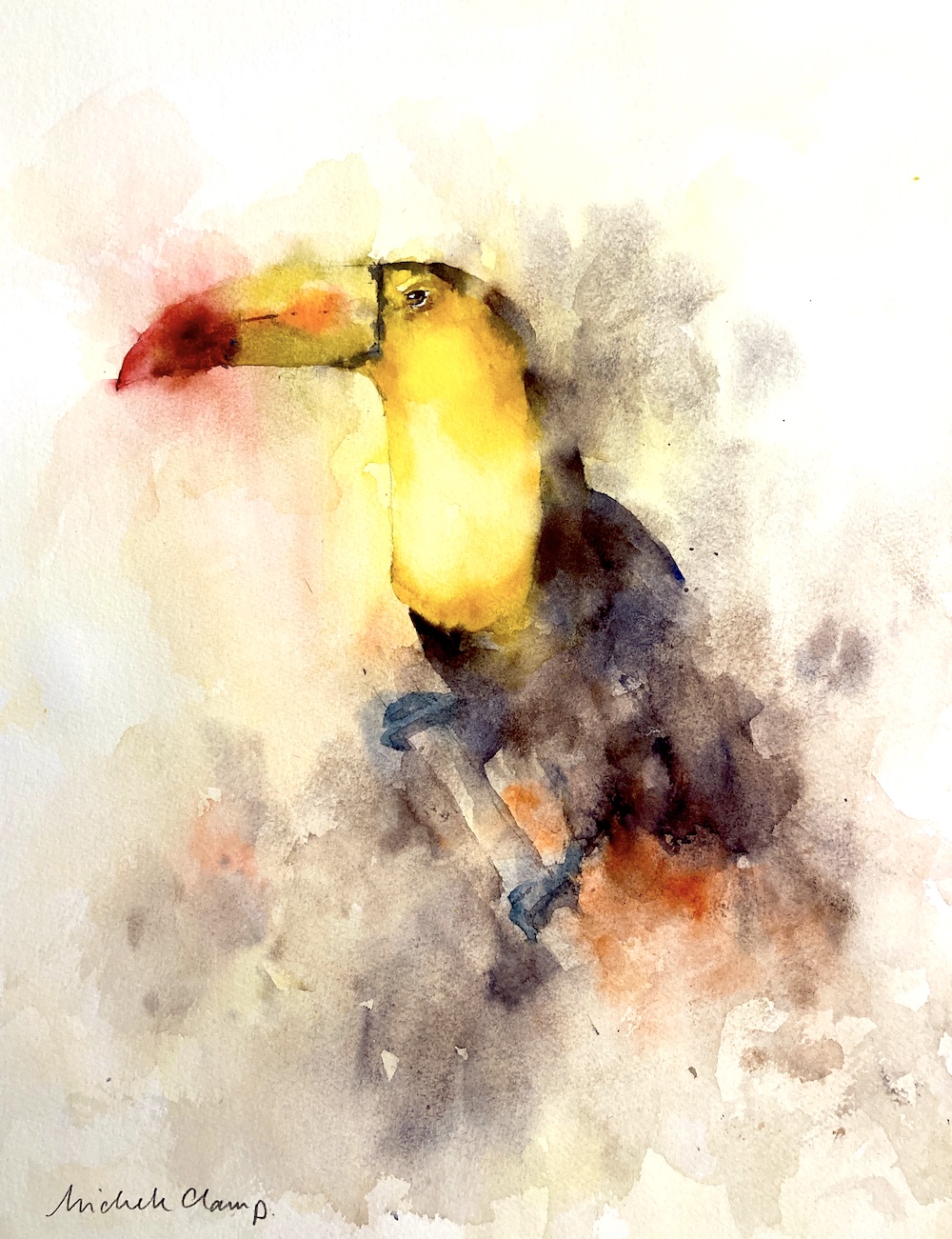Painting a watercolor toucan was the subject today. Exotic tropical birds are often highly colorful which is very attractive but can pose some problems in paint. Each color needs to be modified as the from turns from the light into the shadow. This means a lot of close observation and a lot of mixing. However, for this reference I decided to simplify the colors a little. There was a lot of pretty bright green and yellow in the reference. I chose to tone down the green and also move the greenish yellow more towards orange. The aim was to have more unified color scheme. I also decided to ditch the jungle of foliage. For another painting this could have been fun to do but I wanted to focus in on the toucan bird and not have anything competing with it.
Watercolor Toucan

First make a plan
The plan for this bird watercolor was to proceed along the same lines as a previous cardinal watercolor painting. I wanted to start by putting down lots of regions of soft edged misty color and not pay too much attention to the edges. As the painting progresses more and more edges are put in until the bird magically appears from the mist. It’s a fun way to paint and I really like the resulting effect. It’s a technique very well suited to bird art and you can end up with an almost abstract painting at the end.
Materials for your Watercolor Toucan
It’s pretty much essential to work on good 100% cotton watercolor paper for this. The paper can take a lot of working and also keeps damp for a fair while. This allows us to work into the paint wet-in-wet and soften edges as we go. It is possible to use cheaper paper but I wouldn’t recommend it unless you have a lot of experience under your belt. Trust me – I’ve learned this the hard way. My favored paper is Fabriano Artistico 140lb cold press but any cold press 100% cotton paper is fine. Arches can be a good choice for this. It is slightly more absorbent than the Fabriano and so stays damp for longer. This gives us more time to think as we’re painting without that panic that we have to get everything done at top speed.
A couple of good brushes are needed. I use Escoda reserva sizes 12,10 and 8. They point well and hold a lot of water. However a good synthetic (Princeton Aqua Elite, Black Velvet or Escoda Versatil) is fine and there isn’t so much sticker shock.
For paint I use mainly Da Vinci with a sprinkling of Holbein, Winsor and Newton, Daniel Smith and a couple of others. Any artists quality paint is good and some student paint is also fine (Cotman or Lukas Studio work well). My colors are lemon yellow, cadmium orange, vermillion, permanent rose, burnt sienna, cerulean blue, ultramarine and lamp black.
We can work without stress on preliminary sketches


These two sketches were just to get the brushes warmed up and to play with the colors and the shapes. I mostly wanted to see how much detail I could lose but still keep the essence of the bird. It turned out that the chinstrap was a big focal point. A surprise was that keeping the beak too sharp really detracted from the rest so I made a note to be careful about keeping a lot of that beak soft.
Keep the Drawing simple
As we’re going to be working loosely on this watercolor bird I don’t want too much graphite showing through. So the drawing was kept light and only the most essential lines put in. I lightly outlines the beak, the eye, the rough shape of the body and the legs and feet. For the feet I just drew in the main shape and didn’t bother noodling around drawing individual claws. They’re not the main focus and will just distract the viewer.
First washes – go nuts with those edges
This first bit is lots of fun and is really hard to go wrong here. I took the main colors (mostly lemon yellow for the chest and beak and a mix of ultramarine/burnt sienna for the body) and just sploshed some paint in the rough area they should be. Use a big brush for this – we don’t want little dibby dabby lines at this point.


Once the paint dabs were down I thoroughly cleaned my brush, loaded it up with water and softened all the hard edges of the paint. Don’t be afraid of painting through the edges here. In fact really try and pull that paint through the outline of the bird into the background. Keep loading up with water and soften anything that looks like a hard edge – it should look nothing like a bird at this point!!
Careful of the eye area
The only thing to be careful of is the eye area. We want to keep that area nice and crisp so try and keep dark paint away from that area. If, by chance, you do paint over it by mistake you can probably take a piece of paper towel and lift the paint off while it’s wet.
Slosh in some dark mixes for the body area


With my mix of ultramarine and burnt sienna I started putting in marks rough where the body was going to be. Again I pulled that color out through the edges of the bird into the background. Even pull it through the feet – these are fairly dark anyway and we can paint over them later. If you want to splatter some darks inot the wet paint go ahead. It will add some texture and visual interest. Just keep those edges soft! There shouldn’t be a hard line to be seen.





